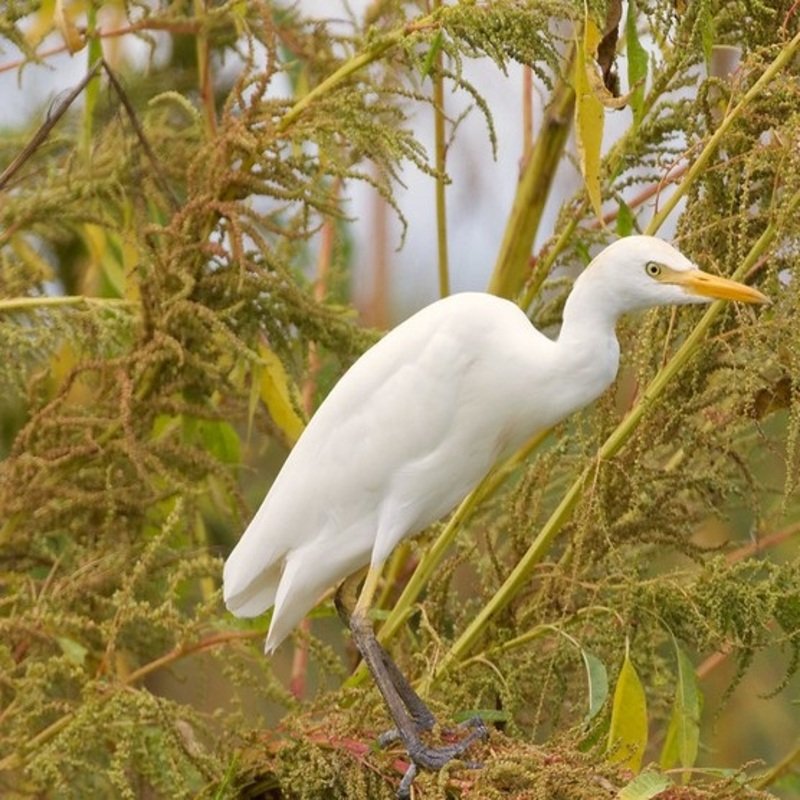Tropical, subtropical, and warm-temperate zones are home to this heron in the family Ardeidae species of Bubulcus ibis. Western cow egret and Eastern cattle egret are considered separate species by some writers. Contrary to popular belief, the Ardean heron is not related to Egretta egrets, despite its plumage.
Quick Overview: Bubulcus Ibis – Cattle Egret
Body size: Around 19-21 in (48-53 cm) and a weight of 510 g (17-98 oz)
Main colors: White, Orange, Yellow
Range: South Eastern and the Central United States
Migratory Bird: Yes
Best time of the year to see in the U.S.: June, July, August, September
Conservation Status: Least Concern
Cattle Egret Description
They are medium-sized birds that stand straight with a “hunched” stance. A typical egret with short legs and a big neck. Adults are all white, with a pale orange or yellow bill and legs. During the breeding season, the breeding adults’ plumage becomes buffy, with crimson eyes, legs, and beak. It is also known as the Buff-Backed Heron because of its buff-colored back and wings.

Size
These birds have a length of 19-21 in (48-53 cm) and a weight of 510 g (17-98 oz). Their wings could range from 36-38 in (91-97 cm).
Feeding
An individual cow egret may collect up to 50% more food by associating with cattle and other large ungulate species while consuming only two-thirds the energy to catch it, researchers discovered. Because of this, it is an uncompetitive feeder. In addition to wild buffalo, it is frequently accompanied by hippopotamuses, zebras, and waterbucks. Cattle egrets are commonly misidentified as tick-birds due to their propensity of perching on the backs of these animals. A kangaroo and a horse have been seen in Australia along with them.
Habitat
Land-adapted cattle egrets thrive in a wide range of land and water habitats. Animal grazing sites are not required for it to survive, although it visits them. It also fits well in cities. When breeding, it typically uses ardeid heronries produced by native ardeids.
Behavior
In fact, the cattle egret prefers to be near grazing livestock. Like many colonial waterbirds, it tends to roost in large groups. It migrates a lot. Due to their propensity for lengthy wandering, distinguishing between migration and dispersal in cattle egrets can be tricky. It often congregates with other ardeids during migration. They also flock together to forage, nest, and roost. During the flight, it tucks its neck close to its body. The neck is rarely stretched even when relaxed. Like a goose, it walks with a swinging gait.
Bubulcus Ibis Scientific Classification
- Kingdom: Animalia
- Phylum: Chordata
- Subphylum: Chelicerata
- Class: Aves
- Order: Pelecaniformes
- Family: Ardeidae
- Genus: Bubulcus
- Species: Bubulcus ibis
Best time of the year to see
The best time to see these birds in the United States is during the winter season (December to February).
Distribution of the Cattle Egret in the USA
North America, South America, Europe, Africa, Asia, and Australia are all home to this species. This bird was not always widespread in all of these locations; it is believed to have originated in central Africa and then expanded over the world throughout the nineteenth century.
The Cattle egret can be found in the following states in the United States – Alabama, Alaska, Arizona, Arkansas, California, Colorado, Connecticut, Delaware, Florida, Georgia, Hawaii, Idaho, Illinois, Indiana, Kansas, Kentucky, Louisiana, Maine, Maryland, Massachusetts, Michigan, Mississippi, Missouri, Nebraska, Nevada, New Hampshire, New Jersey, New Mexico, New York, North Carolina, North Dakota, Ohio, Oklahoma, Oregon, Pennsylvania, Rhode Island, South Carolina, South Dakota, Tennessee, Texas, Utah, Vermont, Virginia, Washington, West Virginia, and Wisconsin.

